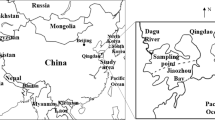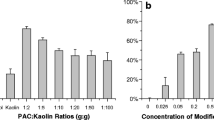Abstract
Large differences occur between the removal efficiencies (RE) of polyaluminum chloride modified clay (PAC-MC) suspensions prepared using deionized water (DW) and seawater (SW). This showed that physicochemical properties of PAC-MC suspension influenced its ability to remove algal cells. The efficiency at which a PAC-MC suspension removed Aureococcus anophagefferens (CCMP 1984) and Phaeocystis globosa from water was determined using diluted seawater (DSW), dissolved ion species, ion concentrations, pH, temperatures, and suspension aging times. The RE decreased generally as the percentage of seawater increased, and the RE was higher for PAC-MC prepared using DW than that using SW. The ion species present and the ion concentrations in the suspension influenced the RE, with sulfate negatively affecting the RE more than the other ions tested. Sulfate in the PAC-MC suspension showed a “V”-shaped effect which can be partially explained by charge neutralization and “patch coagulation” that played different parts in the flocculation process. The effects of pH of PAC-MC suspension on the RE were greatly influenced by the dispersion medium. The RE of the PAC-MC suspended in DW decreased gradually, whereas RE of the PAC-MC suspended in SW followed a V-shaped trend, as the pH was increased. Surface charge is an important aspect in the removal mechanism of PAC-MC, but the flocculation behavior at low suspension pH conditions is less clear. Temperature and suspension aging time had no obvious effects on the RE. Appropriate explanation and mechanism is also proposed in the discussion. These studies showed that the RE could be further improved given proper attention to the properties of PAC-MC suspension.







Similar content being viewed by others
References
Anderson DM (1997) Turning back the harmful red tide. Nature 388:513–514
Anderson DM, Cembella AD, Hallegraeff GM (2012) Progress in understanding harmful algal blooms: paradigm shifts and new technologies for research, monitoring, and management. Annu Rev Mar Sci 4:143–176
Ayoub GM, Lee S-I, Koopman B (1986) Seawater induced algal flocculation. Water Res 20:1265–1271
Barnes H (1954) Some tables for the ionic composition of sea water. J Exp Biol 31:582–588
Chen J, Pan G (2012) Harmful algal blooms mitigation using clay/soil/sand modified with xanthan and calcium hydroxide. J Appl Phycol 24:1183–1189
De Hek H, Stol RJ, De Bruyn PL (1978) Hydrolysis-precipitation studies of aluminum (III) solutions. 3. The role of the sulfate ion. J Colloid Interface Sci 64:72–89
Guenther M, Bozelli R (2004) Factors influencing algae–clay aggregation. Hydrobiologia 523:217–223
Guillard RRL, Hargraves PE (1993) Stichochrysis immobilis is a diatom, not a chrysophyte. Phycologia 32:234–236
Gupta V, Miller JD (2010) Surface force measurements at the basal planes of ordered kaolinite particles. J Colloid Interface Sci 344:362–371
Hagström JA, Granéli E (2005) Removal of Prymnesium parvum (Haptophyceae) cells under different nutrient conditions by clay. Harmful Algae 4:249–260
Hallegraeff GM (1993) A review of harmful algal blooms and their apparent global increase. Phycologia 32:79–99
Han MY, Kim W (2001) A theoretical consideration of algae removal with clays. Microchem J 68:157–161
Kim HG (2006) Mitigation and controls of HABs. In: Granéli E, Turner J (eds) Ecology of Harmful Algae. Springer, Berlin, pp 327–338
Li L, Pan G (2013) A universal method for flocculating harmful algal blooms in marine and fresh waters using modified sand. Env Sci Technol 47:4555–4562
Liang J-J, Li Y-H, Liu F, Li H-Y, Liu J-S, Yang W-D (2015) Experimental removal of Alexandrium tamarense cells using sulfobetaines and their modified clays. J Appl Phycol:doi: 10.1007/s10811-014-0482-4
Liu G, Fan C, Zhong J, Zhang L, Ding S, Yan S, Han S (2010) Using hexadecyl trimethyl ammonium bromide (CTAB) modified clays to clean the Microcystis aeruginosa blooms in Lake Taihu, China. Harmful Algae 9:413–418
Maruyama T, Yamada R, Usui K, Suzuki H, Yoshida T (1987) Removal of marine red tide planktons with acid treated clay. Nippon Suisan Gakkaishi 53:1811–1819 (In Japanese with English abstract)
Olphen HV (1977) An introduction to clay colloid chemistry, for clay technologists, geologists, and soil scientists, 2nd edn. Wiley, New York
Padilla L, San Diego-McGlone M, Azanza R (2010) Exploring the potential of clay in mitigating Pyrodinium bahamense var. compressum and other harmful algal species in the Philippines. J Appl Phycol 22:761–768
Pan G, Chen J, Anderson DM (2011) Modified local sands for the mitigation of harmful algal blooms. Harmful Algae 10:381–387
Rao SM, Sridharan A (1984) Mechanism of sulfate adsorption by kaolinite. Clays Clay Minerals 32:414–418
Semerjian L, Ayoub GM (2003) High-pH–magnesium coagulation–flocculation in wastewater treatment. Adv Env Res 7:389–403
Sengco MR, Li A, Tugend K, Kulis D, Anderson DM (2001) Removal of red- and brown-tide cells using clay flocculation. I. Laboratory culture experiments with Gymnodinium breve and Aureococcus anophagefferens. Mar Ecol Prog Ser 210:41–53
Sengco MR, Anderson DM (2004) Controlling harmful algal blooms through clay flocculation. J Eukar Microbiol 51:169–172
Shirota A (1989) Red tide problem and countermeasures (2). Int J Aquat Fish Technol 1:195–223
Wang D, Tang H, Gregory J (2002) Relative importance of charge neutralization and precipitation on coagulation of kaolin with PAC: effect of sulfate ion. Env Sci Techno 36:1815–1820
Wang H, Yu Z, Cao X, Song X (2011) Fractal dimensions of flocs between clay particles and HAB organisms. Chinese J Oceanol Limnol 29:656–663
Wu T, Yan X, Cai X, Tan S, Li H, Liu J, Yang W (2010) Removal of Chattonella marina with clay minerals modified with a gemini surfactant. Appl Clay Sci 50:604–607
Yu Z, Sengco M, Anderson D (2004) Flocculation and removal of the brown tide organism, Aureococcus anophagefferens (Chrysophyceae), using clays. J Appl Phycol 16:101–110
Yu Z, Sun X, Song X, Zhang B (1999) Clay surface modification and its coagulation of red tide organisms. Chinese Science Bull 44:617–620
Yu Z, Zou J, Ma X (1994a) Application of clays to removal of red tide organisms I. Coagulation of red tide organisms with clays. Chinese J Oceanol Limnol 12:193–200
Yu Z, Zou J, Ma X (1994b) Application of clays to removal of red tide organisms II. Coagulation of different species of red tide organisms with montmorillonite and effect of clay pretreatment. Chinese J Oceanol Limnol 12:316–324
Yu Z, Zou J, Ma X (1994c) A new method to improve the capability of clays for removing red tide organisms. Oceanol Limnol Sinica 25:226–232 (In Chinese with English abstract)
Yu Z, Zou J, Ma X (1995) Application of clays to removal of red tide organisms III. The coagulation of kaolin on red tide organisms. Chinese J Oceanol Limnol 13:62–70
Zhang Y, Yu Z, Song X, Cao X, Liu Y (2013) Study on removal of brown tide-Aureococcus anophagefferens by modified clay. Acta Oceaol Sinica 35:197–203 (In Chinese with English abstract)
Acknowledgments
We would like to thank Dr. Guang-yuan Lu for his kind advice in paper writing. This work was supported by National Natural Science Foundation of China (NSFC)-Shandong Joint Fund for Marine Science Research Centers (Grant No. U1406403), the Strategic Priority Research Program of the Chinese Academy of Sciences (Grant No. XDA11020302), the Chinese State Oceanic Administration public welfare project (Grant No. 201305003–3) and the National Natural Science Foundation of China (NSFC) (Grant No.41576119).
Author information
Authors and Affiliations
Corresponding authors
Rights and permissions
About this article
Cite this article
Liu, Y., Cao, X., Yu, Z. et al. Flocculation of harmful algal cells using modified clay: effects of the properties of the clay suspension. J Appl Phycol 28, 1623–1633 (2016). https://doi.org/10.1007/s10811-015-0735-x
Received:
Revised:
Accepted:
Published:
Issue Date:
DOI: https://doi.org/10.1007/s10811-015-0735-x




